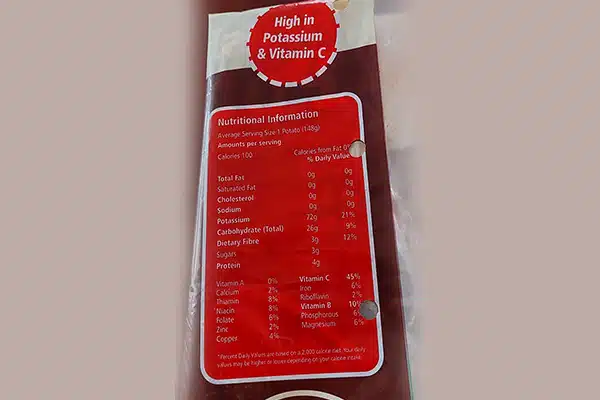I have recently been looking at some labels on food I have purchased – well in reality, I look at the labelling of food a lot.
This product was packaged potatoes and there were a couple of things that caught my eye.
The first one was that there were claims on the bag which then generated the need for nutrition information to be included about the potatoes – generally there is an exemption for vegetables that are a single ingredient food from needing nutrition information on the package.
However, the bag of potatoes claimed that they were high in potassium and vitamin C. This is not a problem provided that they meet the requirements to make a high in claim and the labelling requirements are met. The packaging included nutritional information, but it was in the wrong format.
The Food Standards Code specifies the format and the nutrients that must be included. There are different formats for nutrition information around the world. Some require very similar details whereas others have significantly different formats.
One of the common errors made is the use of the USA format. This is one of the significantly different formats to the Australian format.
Let’s look at some of the other parts of the nutritional information that do not meet the Australian requirements. Products sold in Australia must have a per serve column and a per 100 g (or 100 mL) column – the nutrition information shown here only details the nutrition amounts for 1 serving of the potatoes.
The nutrients are stated in the incorrect order and the inclusion of some of the vitamins and minerals are not permitted for Australia as there must be at least 10% of the recommended dietary intake in a serving of the food. The inclusion of vitamins and minerals in the nutrition information panel is considered a claim under the Australian legislation because these are considered as being included voluntarily and are therefore nutrient content claims.. Some of the nutrients state 0% – these may be permitted to be stated this way according to the USA format – but this is not the case for Australia.
The declaration for vitamins and minerals must include the % Recommended Dietary Intake (%RDI) that is specified for Australia and the nutrition information for those that are included must state the actual amounts.
There also seems to be incorrect units used for the potassium as it is highly unlikely that there is 26 g of potassium in a serving of potatoes. There is no specified daily amount for potassium for Australian labelling purposes, so it is unclear how the % amount for is determined here. Sodium units in the nutrition information panel must also be in mg, not g.
The summary is – make sure the format is the right one and the nutrients you state are permitted and in the correct order. If claims are made, make sure that they comply with the requirements for Australia. Make sure your units and the amounts stated are correct.





